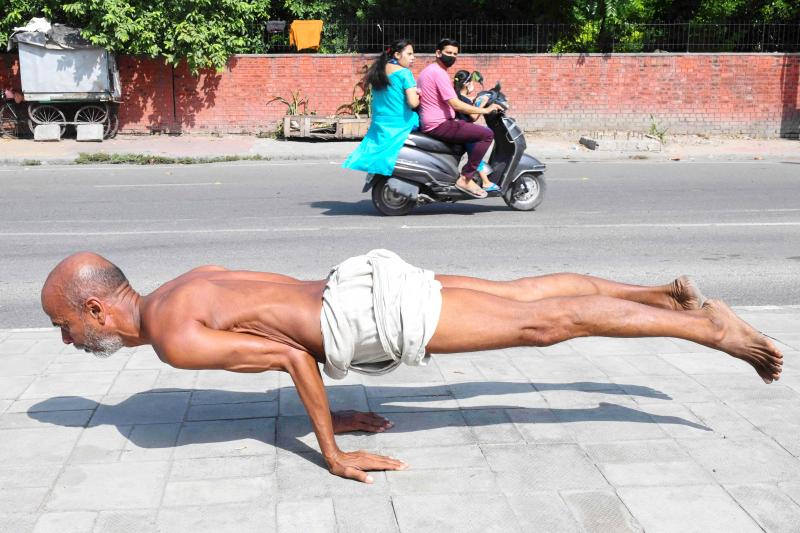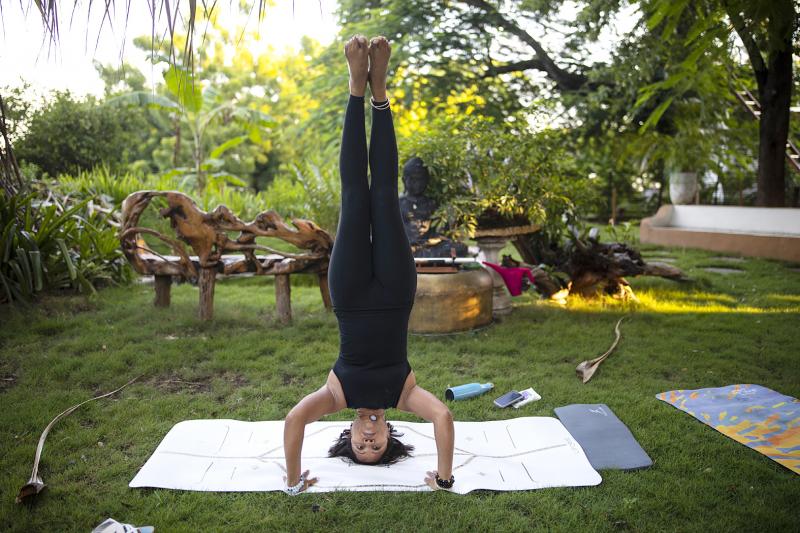Back pain is the most common form of chronic pain. The most effective way to manage chronic back pain is with a multidisciplinary approach, of which exercise is a key component.
“Any single treatment in low back pain is never enough by itself,” says Michael Vagg, a pain medicine physician and dean of the faculty of pain medicine at the Australian and New Zealand College of Anaesthetists. “But exercise is a fundamental part of recovering from low back pain and managing it if it becomes persistent.”
But people who have suffered from back pain for a long time might feel fearful of moving.

Photo: AFP
Matthew Bagg, a physiotherapist and pain scientist at Curtin University, says the first big challenge for people with chronic back pain is understanding that pain is not an accurate indication of the robustness of their body.
“Regardless of how they feel, they are not broken, damaged or falling apart,” Bagg says. “If it hurts to do something, people are likely to do less of it.”
But those who remain active tend to have better outcomes in the long term. “Even when we experience back pain, it doesn’t mean that we shouldn’t be moving.”

Photo: AP
“Pain itself isn’t an issue,” agrees Rob Laird, a musculoskeletal physiotherapist. But increasing pain during and after exercise is a red flag, he says. “Exercise should reduce, not increase, pain.”
There is limited evidence to suggest that one type of exercise is better than another when it comes to chronic back pain. “The best exercise is one that you will keep doing and enjoy,” Bagg says.
Laird says physical activity for chronic back pain should include three domains: strength, mobility, and cardiovascular fitness.
Consulting a GP or a physiotherapist before starting an exercise routine for chronic back pain is strongly recommended. But here are some practical tips that can help you stay active.
In a study published in October in the Journal of Physiotherapy, Bagg and his colleagues conducted a statistical analysis that combined the results of multiple clinical trials of exercise therapies for people with long-term back pain.
They found some evidence suggesting that pilates exercise might have the most significant effects on pain intensity.
Pilates classes include a series of exercises that focus on the stability and mobility of the body, particularly the spine, core and pelvic area.
It emphasizes the “neutral spine position” — the natural curves in our spine that provide stability and mobility for taking on the weight and pressure of our bodies. Pilates exercises also help strengthen legs and gluteal muscles, shoulders and arms.
Laird advises strengthening lower limb and gluteal muscles because these are the muscles we use when we bend or move from sitting to standing. “If they are underdone, the back muscles have to work harder.”
Because exercising legs and glutes does not involve excessively recruiting back muscles, he says, most people feel safe doing it. Laird suggests beginning with the classic pilates roll down and progressing to single knee squats.
To start a roll down, imagine standing against a wall, then think of peeling your spine off the wall one vertebra at a time, beginning by tucking the chin in, rolling the neck and slowly going down to the pelvis. Your knees are slightly bent, and you might feel some pressure in your hamstrings. To come back up, roll the pelvis first, then the spine, one vertebra at a time. Neck and head come up last.
The second part of the exercise targets the gluteus maximus. Roll down again one vertebra at a time, place one hand on a chair to balance and lift one foot off the ground. Bend the knee of the standing leg, then push through the heel and come back up. Aim to five to 10 repetitions and change side.
Reduced mobility of the spine has a poor impact on back function, Laird says. A simple exercise that can help improve back mobility is the cat-cow stretch.
Start in a four-point kneeling position with your hands under your shoulders and knees under your hips. Breathing in, allow your stomach to drop down slowly and tilt your pelvis forward. As you exhale, arch your back up by tucking your tailbone in and pulling your belly button in towards your spine.
Laird says brisk walks, cycling or swimming are great ways to include cardiovascular fitness in your training. These are all activities most people with chronic back pain can do, he says. “Cardiovascular fitness is essential. If you are not fit enough to walk around the block easily, you are going to struggle with life in general, and pain is still going to be a real problem.”
Laird does not encourage taking up running. “Running is not recommended at the start of a recovery plan but can be used in younger patients towards the middle to end of their recovery plan,” he says.
“It’s less useful in older patients — over 60 approximately, although there are always some exceptions — because of the impact loading when there is significant degenerative change already present.”

May 11 to May 18 The original Taichung Railway Station was long thought to have been completely razed. Opening on May 15, 1905, the one-story wooden structure soon outgrew its purpose and was replaced in 1917 by a grandiose, Western-style station. During construction on the third-generation station in 2017, workers discovered the service pit for the original station’s locomotive depot. A year later, a small wooden building on site was determined by historians to be the first stationmaster’s office, built around 1908. With these findings, the Taichung Railway Station Cultural Park now boasts that it has

The latest Formosa poll released at the end of last month shows confidence in President William Lai (賴清德) plunged 8.1 percent, while satisfaction with the Lai administration fared worse with a drop of 8.5 percent. Those lacking confidence in Lai jumped by 6 percent and dissatisfaction in his administration spiked up 6.7 percent. Confidence in Lai is still strong at 48.6 percent, compared to 43 percent lacking confidence — but this is his worst result overall since he took office. For the first time, dissatisfaction with his administration surpassed satisfaction, 47.3 to 47.1 percent. Though statistically a tie, for most

Six weeks before I embarked on a research mission in Kyoto, I was sitting alone at a bar counter in Melbourne. Next to me, a woman was bragging loudly to a friend: She, too, was heading to Kyoto, I quickly discerned. Except her trip was in four months. And she’d just pulled an all-nighter booking restaurant reservations. As I snooped on the conversation, I broke out in a sweat, panicking because I’d yet to secure a single table. Then I remembered: Eating well in Japan is absolutely not something to lose sleep over. It’s true that the best-known institutions book up faster

In February of this year the Taipei Times reported on the visit of Lienchiang County Commissioner Wang Chung-ming (王忠銘) of the Chinese Nationalist Party (KMT) and a delegation to a lantern festival in Fuzhou’s Mawei District in Fujian Province. “Today, Mawei and Matsu jointly marked the lantern festival,” Wang was quoted as saying, adding that both sides “being of one people,” is a cause for joy. Wang was passing around a common claim of officials of the People’s Republic of China (PRC) and the PRC’s allies and supporters in Taiwan — KMT and the Taiwan People’s Party — and elsewhere: Taiwan and